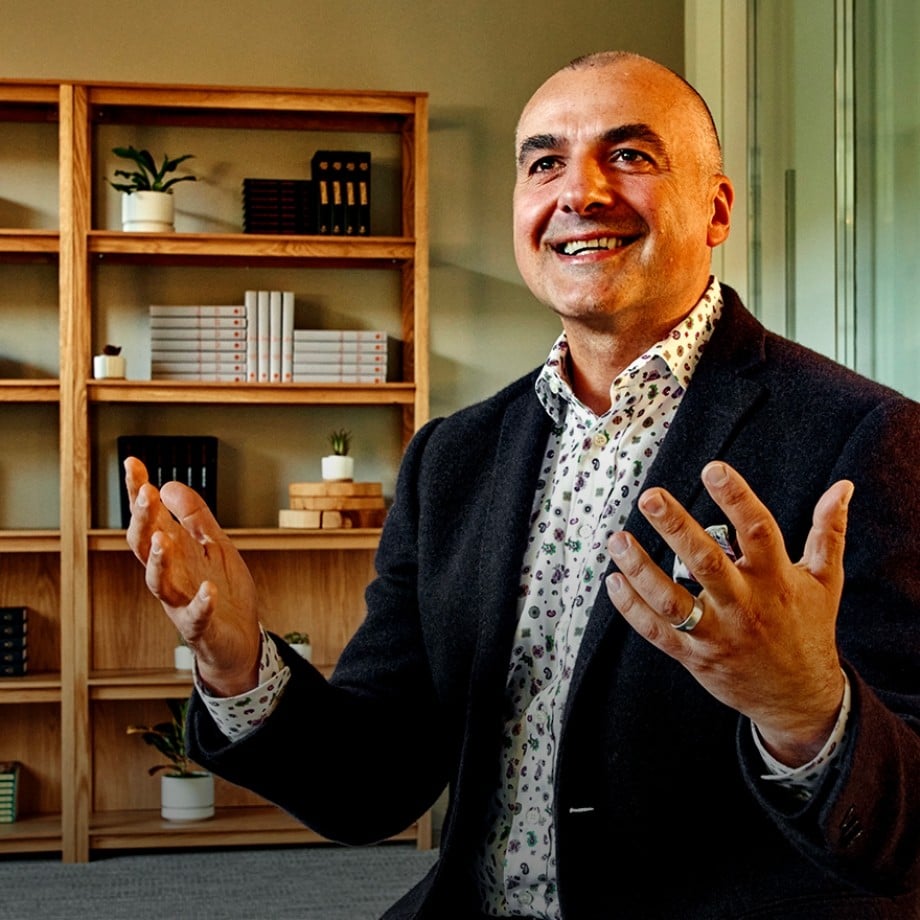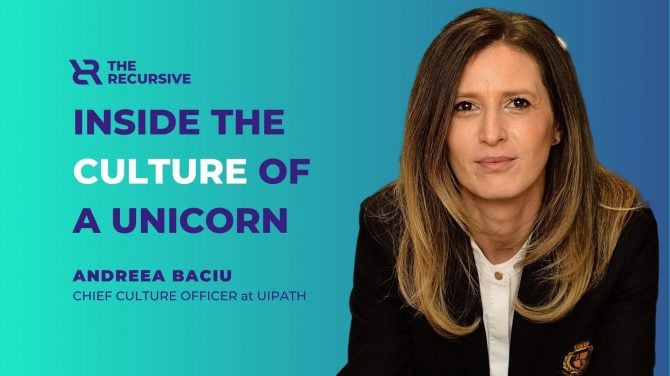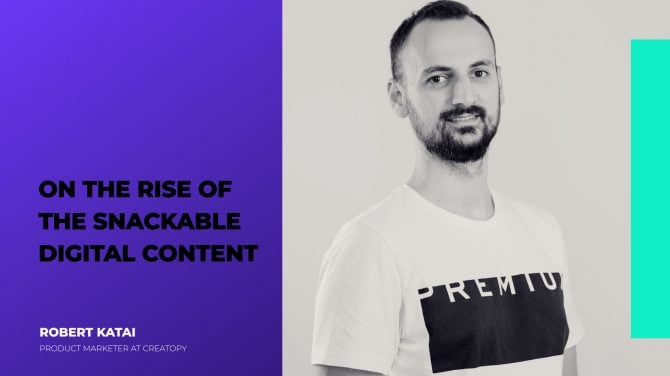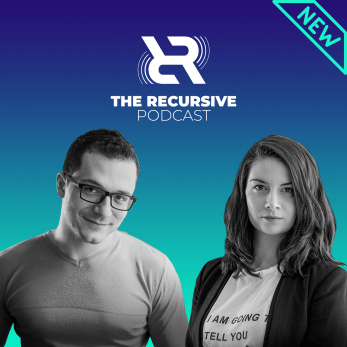Bulgaria has its first unicorn in the face of Payhawk! This is also unicorn number six for Southeast Europe and the third one in 2022.
To follow up on this big news today The Recursive prepared a very interesting discussion with a very special guest, joining all the way from San Francisco. His name is Bogomil Balkansky and he’s a partner at Sequoia Capital, the legendary VC firm behind Apple, Airbnb, Instagram, and many other iconic tech companies.
Bogomil has been living in Silicon Valley for over 20 years and has become one of the most influential people in both the local and the Bulgarian startup ecosystems. Prior to joining Sequoia Capital, he spent eight years at VMware, and under his leadership, the revenue of his product line grew tenfold, and the number of customers increased from 5,000 to 300,000. Later he became vice president of Google after the company acquired bebop, a startup Bogomil had joined as one of the first employees.
He has helped many Bulgarian tech companies set foot in the US. In 2019, he co-founded Bulgaria Innovation Hub, an organization with the mission to create a two-way bridge between Bulgaria and Silicon Valley.
Today, we are going to discuss what being a unicorn means nowadays, whether Southeast Europe is becoming more popular with Silicon Valley VC, when startups from the region should enter the US market, and what it really takes for founders to build globally successful companies.
The Recursive: Payhawk’s unicorn status is a huge milestone for the startup ecosystem in Bulgaria.
But is being a unicorn still considered a big achievement in the US, now that there are over 1000 worldwide, and valuations are getting crazier and crazier?
Bogomil Balkansky: You’re absolutely right. These days being a unicorn is no longer what it used to be. But that by no means diminishes the huge accomplishments of Payhawk and the entire tech ecosystem in Bulgaria to reach that milestone. That’s what it is. It’s a milestone. It’s one point in time, onto a journey that hopefully goes onwards and upwards.
It’s very interesting that just a few months ago, one of your colleagues, a journalist in Bulgaria asked me when I anticipated seeing the first unicorn from Bulgaria. I said in 5 years. So, I am very, very happy to be proven majorly wrong and see the first unicorn only a few months after the interview.

I would say the awareness of our region started changing in a major way after the emergence and the huge success of UiPath. Before UiPath became a hugely successful public company, we had a lot of explaining to do, you know, when you said Bulgaria or Romania, very often the reaction was like, where is that. The truth is that Americans haven’t learned geography any better than they used to know it a few years ago.
But now, at least there is an awareness that something interesting is happening in both countries, Bulgaria and Romania, even if people don’t know exactly where they are. So, I think it is an amazing accomplishment for the Payhawk team and the entire venture ecosystem.
You also correctly noted that there are more than 1000 unicorns, and there are a couple of different trends that are driving the ever-increasing number of unicorns.

If you look back 20 years ago, the number of billion-dollar public tech companies was relatively small. And over the past 20 years, we have seen a huge expansion in opportunities for technology companies, not just measured by valuations, but also the number of different subdomains and segments where there’s opportunity. 10 years ago, there was no such thing as machine learning and AI today, that’s a huge field. Since we were talking about UiPath, for a moment ago, the whole field of robotic process automation (RPA) is one example of a field that didn’t exist even 10 years ago.
So the fundamental underlying trend is that there’s an ever-increasing waterfront of opportunity in technology. I would say that is the fundamental driver why we see more and more unicorns.
In the last few years, it’s very obvious that we’re living in a tech bubble. There has been a dramatic expansion in valuations, which, quite honestly, is driven by the inflation in the stock market. Now, finally, we’re seeing consumer price inflation in a lot of Western countries, both in the US and Europe. But the asset price inflation has been going on. Ever since the pandemic, especially. Actually, it started all the way back after the last recession of 2008, where central banks have been pumping tremendous amounts of newly printed money into the system, which drove interest rates very, very low. Interest rates stayed at historic low levels for more than a decade. And so for almost 15 years now, we have been seeing this bull market, all over the world. And, the bull market, very surprisingly, actually dramatically accelerated during the pandemic, again, very much driven by the tremendous amount of liquidity that was pumped into the system.
So this is the short term reason for seeing so many unicorns, there’s an argument to be made that at some point, the music is going to stop, and this party is going to end and the valuation multiples will revert to the mean or come back to more sustainable levels. But even if and when that happens, the underlying trend that there’s an ever-expanding opportunity in technology still remains.
Is the increasing number of unicorns in Southeast Europe improving the brand of the region in the eyes of Silicon Valley VCs?
Honestly, VC companies are just looking for compelling investment opportunities. Compelling investment opportunities means fast-growing companies. Companies that first of all have compelling teams going after what could be a big market. And honestly, the majority of investors are pretty indiscriminant when it comes to where these opportunities come from.

It’s very unlikely that the Silicon Valley investor would be interested in a Bulgarian or Romanian or a Serbian startup that’s only focused on the local market. But as long as entrepreneurs are high-quality founders, and they’re going after big markets, honestly, investors don’t particularly care if your name sounds Bulgarian, or Romanian, or whatever. So from that perspective, again, the only thing that investors are chasing is opportunity.
Now, when it comes to our region, specifically, I would say that investors also need to be time-efficient in terms of how they cover different markets. The truth of the matter is that for the time being, Southeast Europe probably ranks, I would say, 5th or 6th, just on the rank list of the number of successful companies that have come out in Europe.
Obviously, Western Europe is still the biggest market. And, within Western Europe, historically, the UK has been the most important entrepreneurial market, probably followed by France and Germany, the Scandinavian countries. These are then followed by the Baltic countries where you have Estonia, which is a tiny country, even compared to Bulgaria, but punches way above its weight when it comes to technology and entrepreneurship. It is the birthplace of companies like Skype, TransferWise, and like Bolt in which Sequoia Capital invested recently. Then you have Central Europe where you have the Czech Republic and Poland. We haven’t yet seen tremendous successes from both countries, not of the magnitude of UiPath, from Romania. But just by the sheer numbers of significant outcomes, Central Europe is still probably ahead of Southeast Europe.
But all in all, I think investors are starting to pay attention to our region. And when it comes to Sequoia Capital specifically, it so happens that two of us, myself and Luciana Lixandru come from Southeast Europe. So we have taken it upon ourselves to cover the Bulgarian and the Romanian tech ecosystems respectively.
Is there a right timing for European startups to expand to the US?
Yes, there is. As soon as possible. Again, Bulgarian startups would be interesting only if they have global ambitions and if you have global ambitions, you should go after your global customers from the very beginning. It’s not that useful or efficient to be designing solutions that are only appropriate for the Bulgarian or for the Southeast Europe market.
From the very beginning, you should focus on your global customers, and probably the most efficient thing to do is immediately to go to the American market. I’ve been telling this to all the participants in our Bulgarian Innovation Hub program.
If you are planning to conquer international markets, going to Western Europe first is tough because, for cultural and language reasons, Western Europe is still not a single market. From that perspective, it’s way more efficient to try to focus on the American market than on the European market.

But isn’t the US market much more competitive if you want to get funding from a top-tier VC?
I don’t think so quite honestly. And I think you can see that in the valuations in the US versus Europe, there is still a gap between the valuations that American startups get from American VCs versus the valuations European startups get from European VCs. This gap is closing quickly, by the way, but it still exists.
If you believe that the market is supply and demand, the fact that it’s easier to get a higher valuation in the US basically tells you that the US is the entrepreneurs market. In other words, yes, there are a lot more startups but there’s way more capital, chasing the startups. Because of that, founders are better positioned to get a better deal for their company from American VCs rather than European VCs.
On the Sequoia Capital website, you say that you’re looking for iconoclastic thinkers. In many ways, for the startup ecosystem in Southeast Europe to grow, we need many more of those.
Can you tell us more about what true iconoclasts do?
It’s just like art – it doesn’t come from a place of being a happy-go-lucky, well-adjusted person. Great art comes from being chased by demons of some sort. If you look at the biographies of many famous artists, they struggled with various demons in their lives. But those are the creative forces, the creative juices that compel you to produce great artwork. In that way, entrepreneurship is very similar to art.
Great founders and great entrepreneurs are not these well-adjusted happy-go-lucky people. You know, if you’re that kind of person, what you usually do is you just take a job with a big company or a small company, or whatever, and you’re just happy going through your life.
Great entrepreneurs become entrepreneurs because they’re not satisfied with the status quo. They’re not satisfied with an average outcome. They have a chip on their shoulder, they’re chased by demons, you know, however, want to phrase this.
But because of that, they are the kind of people who don’t accept conventional thinking. They’re the kind of people who are not satisfied with the status quo. They’re the kind of people who always ask the question why. And they’re the kind of people who think everything through first principles.

And that is the kernel of a great company in the making, you need to start with some spark, some stroke of inspiration, some unconventional idea that quite honestly, at the very beginning, might seem ridiculous.
I’m almost tempted to quote Gandhi here – he famously said, at first, they ignore you, then they laugh at you. And then you finally win. And I think that is oftentimes the trajectory or the life arc of a lot of great entrepreneurs, they’re first ignored, they’re on the margin, they’re not popular, then when they start a company with some seemingly crazy idea, and they’re really ridiculed, and then, they finally win.
One great example from our portfolio is Airbnb. The story of how difficult it was for them to raise their first round of funding is very famous now. I forget how many VCs they talked to, but basically, they’re laughed out of so many VC boardrooms. Because what a crazy idea – who’s gonna admit a stranger in their house and let them sleep like in their spare bedroom? That’s crazy, right? You know, what if that person is a criminal?
12 years later, Airbnb is an immensely powerful business. And it’s a service that hundreds of millions of people around the world use. And over and over again, we have seen in our portfolio that most iconoclasts make the best entrepreneurs.. And that’s why these are the kinds of people that we’re looking to partner with.
What’s the craziest investment of Bogomil Balkansky?
I don’t know if I personally can take a lot of credit for crazy ideas. I focus mostly on geeky stuff – developer tools, DevOps data infrastructure, I would say that in enterprise investing, you don’t see the craziest ideas, you tend to see the crazier ideas in consumer investing.
One example that I’ll give you is a company called Temporal, where the founders have been working on the problem that they’re solving for 20 years, they literally started in 2004. They created one product when they were at Microsoft and then created a different product, when they went to AWS, then they created a third iteration of that idea when they went to Uber.
For 15 years of their careers what they’re working on, quite honestly, wasn’t accepted or adopted by the markets. It took that long for the right time to come for their idea. But today, this is a company that is flourishing. So that’s another UiPath-like example, where if you know the history of UiPath, the company was founded in the early 2000s, in a Bucharest apartment. For the first 15 years of the company’s history, nothing interesting was happening. Before all of a sudden, it exploded. Temporal, where I’m on the board, seems to be on a similar trajectory.
Last year, Sequoia Capital announced its intention to abandon the traditional VC model with ~10-year fund cycles.
From your perspective, how would this change the VC industry - do you expect similar structures to become more widely adopted? What was the feedback from your LPs?
Well, most inventions tend to be copied and emulated. I do expect that the Sequoia Capital Fund will be emulated over the years, I think it will have an impact on the venture industry. The spirit of it is that we have always wanted to be the most important and the most supportive partner for our entrepreneurs. The Sequoia Capital vehicle is a way for us to stay close to the company not just for 10 years, but for a lot longer. And in retrospect, it allows us to execute on a major part of what has always been our charter and our belief.
The feedback from LPs has been overwhelmingly positive. Because it’s a truism in the investing world to know that the majority of the value accrues after the IPO after the companies go public. It makes a lot of sense that we should stay long-term shareholders in the successful companies that we invested in at the earliest of stages. So, from that perspective, the reaction of our LPs has been very, very positive, because they do recognize that at the end of day, this new structure means stronger returns for them.
What’d be your number one advice to young entrepreneurs in Bulgaria?
Obsess about building long-term sustainable value for customers and building a sustainable business. In a very frothy environment like today, it’s very easy to get distracted and to focus on the wrong things. The trappings of being of high valuation, of hiring a lot of people, of raising money.
The substance, what is going to accrue value over time is creating value for customers and focusing on the customer. So, going back to basics is the best advice that I can give to anybody.






